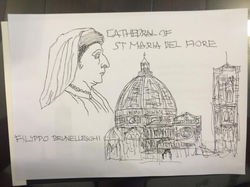top of page
ARCHITECTURE CULTURE & HISTORY 1
PROJECT : PERCEDENT STUDY AND ANALYSIS
This project focuses on investigating historical works to enrich architectural design and ideas. Through the study of existing buildings, students are able to communicate and expand their own architectural vocabulary and develop design concepts. In a group of 5, students are required to conduct precedent study analysis on specific building through on-line forum discussion, analysis drawings, verbal and board presentations. This precedent study analysis should help clarify the research question of “why” that specific building is historically, culturally and architecturally importance; and “how” the design concepts derived from that particular building can be developed and expanded to be creatively and innovatively integrated into their Studio 1 design project.
PART I: Online Discussion Forum
On-line Group Forum Task: Each group is required to collectively address the questions below via TIMES WikiSpace discussion forum. As such each student in the group needs to only select just one set of questions. All discussion must be posted in TIMES Wiki Space in the form of: a. clear and legible photographs and scanned sketches b. short brief /write-up. Brief General/Background
Questions:
1. i. Who was the architect or founder of the building? ii. What was the concept or philosophy of the architect or founder that makes the building historically significant / meaningful?
2. i. Where and when was the building built? ii. How the context, building period and evolution makes the building historically significant and meaningful?
3. i. What is the form, or shape of the building? ii. How the form or shape of the building contributes in making the building historically significant and meaningful?
4. i. What is the function or purpose of the building? ii. How the function or purpose of the building makes the building historically significant and meaningful?
5. i. What were the materials and construction technology or method used? ii. How the materials and construction technology or method help making the building historically significant and meaningful?
SKARA BRAE
PART II: Precedent Study & Analysis Sketches Presentation & Analysis Report
The precedent study and analysis sketches, and analysis presentation board consist of illustrative and abstractive diagrams, drawings and text. The drawings should include actual and conceptual design ideas of floor plans, building sections, analysis diagrams and sketches expressing clarity and in-depth investigation of the precedent studies.
Precedent study and analysis sketches are to be drawn on A4 drawing papers whereas the analysis presentation board should be on an A2 board only and strictly hand-drawn and hand-written. You should find as much information on your assigned building as possible. Some projects have more information available than others. Your assignment is to provide an in-depth analysis of the building and provide thorough reflections of the questions listed in the subsequent section. Analysis should include: A. Answers to the Precedent Study Analysis
Questions below:
1. How does the building reflect the spirit of the time and place for which it was built?
2. What are the initial ideas and the design concept?
3. How the initial ideas and the design concept affecting the architecture?
B. Illustration of Precedent Study Analysis in relation to the series of building conceptual elements listed below – each student is to select and conduct analysis of one element from # 1 to 5 and to synthesize the design concept Partí of # 6.
1. Concept and Architecture analysis (i. Architect and/or Building concepts, ii. Architecture/Style/Identification of Place, iii. Person-Container-Social relationship)
2. Building massing analysis (i. Material and Structure- geometry of making, ii. Geometry - alignment/anthropometry/social geometry/ideal geometry)
3. Circulation Analysis (i. Circulation to Use-Space, ii. Natural ventilation)
4. Spatial Organization analysis (i. Spatial planning & Landscape/Site Siting, ii. Building sequence and process, iii. Public vs. private, iv. Axis, v. Symmetry/Asymmetry & balance, vii. Repetitive to unique, viii. Additive and subtractive, ix. Hierarchy)
5. Building plan-section/elevation analysis (i. Plan to Section or Elevation, ii. Natural light penetration, iii. Significant architectural element)
6. Partí - Culminates and Summarizes (i. gesture, ii. essence, iii, dominant idea, iv salient characteristic of the building)
 |
|---|
 |
 |
 |
 |
 |
 |
 |
 |
 |
 |
 |
PART III: ANALYSIS Presentation Board







bottom of page
